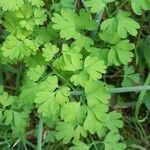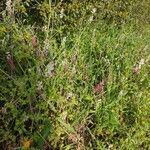Tufted, ± erect, rarely scrambling, annual herb. Lvs quite close-set; lamina dissected, glaucous, up to 8 × 6 cm; segments broad, oblong to oblanceolate to cuneiform. Infl. elongated, with > 20 fls; rachis > peduncle. Peduncle 2-3-(5) cm long. Bracts oblong, acute, < pedicels, 1.5-2 mm long; pedicels spreading to erecto-patent at flowering and fruiting, (2)-3-5 mm long. Sepals elliptic, usually dentate to fimbriate near base, subacute, 2.5-3.5 × 1.5-2 mm. Corolla pink to purplish with dark purple to black wings and tips, 10-13 mm long; lateral and lower petals often with golden yellow midvein; lower petal spoon-shaped at tip but without spreading margins. Fr. globose to obovoid, rugose when dry, weakly keeled, c. 2.5 × 2.5 mm; apex rounded; apical pits small.











